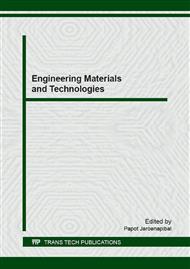[1]
X. Bai, D. H. Isaac, K. Smith, Reprocessing acrylonitrile–butadiene–styrene plastics: structure–property relationships, Polym Eng Sci, 47 (2007) 120-30.
DOI: 10.1002/pen.20681
Google Scholar
[2]
B. E. Tiganis, L. S. Burn, P. Davis, A. J. Hill, Thermal degradation of acrylonitrile–butadiene–styrene (ABS) blends, Polym Degrad Stabil, 76 (2002) 425-34.
DOI: 10.1016/s0141-3910(02)00045-9
Google Scholar
[3]
L.B. Brennan, D.H. Isaac, J.C. Arnold, Recycling of acrylonitrile-butadiene-styrene and high-impact polystyrene from waste computer equipment, J Appl Polym Sci. 86 (2002) 572-578.
DOI: 10.1002/app.10833
Google Scholar
[4]
R. Scaffaro, L. Botta, G. Di Benedetto, Physical properties of virgin-recycled ABS blends: Effect of post-consumer content and reprocessing cycles, Eur. Polym. J. 48 (2012) 637-648.
DOI: 10.1016/j.eurpolymj.2011.12.018
Google Scholar
[5]
R. Balart, J. López, D. García, M. D. Salvador, Recycling of ABS and PC from electrical and electronic waste. Effect of miscibility and previous degradation on final performance of industrial blends, Eur. Polym. J. 41 (2005) 2150-2160.
DOI: 10.1016/j.eurpolymj.2005.04.001
Google Scholar
[6]
S. Anandhan, P. P. De, S. K. De, Anil K. Bhowmick, S. Bandyopadhyay, Novel thermoplastic elastomers based on acrylonitrile-butadiene-styrene terpolymer (ABS) from waste computer equipment and nitrile rubber, Rubber Chem, Technol., 76 (2003).
DOI: 10.5254/1.3547793
Google Scholar
[7]
X. Liu, A. Bodizar, M. Rigdahl, H. Bertilsson, Recycling of blends of acrylonitrile-butadiene-styrene (ABS) and polyamide, J Appl Polym Sci. 86 (2002) 2535-2543.
DOI: 10.1002/app.11098
Google Scholar
[8]
A. Hassan, W. Y. Jwu, Mechanical properties of high impact abs/pc blends – effect of blend ratio, Simposium Polymer Kebangsaan Ke-V Hotel Residence, (2005) 23-24.
Google Scholar
[9]
M.A. Peydro, F. Parres, J.E. Crespo, R. Navarran, Recovery of recycled ABS, through mixing with SEBS. Mechanical, thermal and rheological characterization, J. Mater. Process. Technol., 2012, doi: 10. 1016/j. jmatprotec. 2012. 07. 010.
DOI: 10.1016/j.jmatprotec.2012.07.010
Google Scholar
[10]
D. M. Nguyen, D. T. Tran, T. T. Nguyen, G. Anne-Cécile, H. K. Nam, H. L. Joong, Enhanced mechanical and thermal properties of recycled ABS/Nitrile rubber/nanofil N15 nanocomposites, Compos Part B Eng. 93 (2016) 280–288.
DOI: 10.1016/j.compositesb.2016.03.039
Google Scholar
[11]
M. Rahimi , M. Esfahanian , M. Moradi, Effect of reprocessing on shrinkage and mechanical properties of ABS and investigating the proper blend of virgin and recycled ABS in injection molding, J. Mater. Process. Technol. (2014) 2359–2365.
DOI: 10.1016/j.jmatprotec.2014.04.028
Google Scholar
[12]
Lim J.W., Hassan A., Rahmat A.R., Wahit M.U., Phase morphology and mechanical properties of rubber-toughened polypropylene nanocomposites: effect of elastomer polarity, Polym. Plast. Technol. Eng. 47 (2008) 411-419.
DOI: 10.1080/03602550801898289
Google Scholar
[13]
M. Hernández, M. N. Ichazo, J. González, C. Albano, Orlando Santana, Fracture behavior of polypropylene /elastomer blends, Adv. Mater. Res. 47-50 (2008) 278-281.
DOI: 10.4028/www.scientific.net/amr.47-50.278
Google Scholar
[14]
S. J. Ahn, B. K. Kim, K. H. Lee and H. M. Jeong , Morphology and physical properties of ABS/NBR: The effect of melt viscosity of SAN and the content of NBR, J. Macromol. Sci., Phys., 39 (2000) 691-700.
DOI: 10.1081/mb-100102480
Google Scholar
[15]
J.C. Arnold, S. Alston, A. Holder, Void formation due to gas evolution during the recycling of Acrylonitrile–Butadiene–Styrene copolymer (ABS) from waste electrical and electronic equipment (WEEE), Polym. Degrad. Stab. 94 (2009) 693–700.
DOI: 10.1016/j.polymdegradstab.2008.12.019
Google Scholar
[16]
X. Bai, D.H. Isaac, K. Smith, Reprocessing acrylonitrile–butadiene–styrene plastics: structure–property relationships, Polymer Engineering & Science, 47 (2007) 120–130.
DOI: 10.1002/pen.20681
Google Scholar
[17]
S. C. Chen, W. H. Liao, M. W. Hsieh, R. D. Chien & S. H. Lin, Influence of recycled ABS added to virgin polymers on the physical, mechanical properties and molding characteristics, Polym. Plast. Technol. Eng. 50 (2011) 306-311.
DOI: 10.1080/03602559.2010.531869
Google Scholar


